Mini trampoline exercises provide low-impact workouts perfect for overweight beginners. Start with gentle health bounces to improve balance and circulation. Try seated bouncing, mild marching, and modified mini squats to build strength gradually. Add ankle rolls, foot stretches, and controlled arm movements to enhance mobility without joint strain. Incorporate side-to-side weight shifts and progressive cool-down techniques to reduce injury risk. These beginner-friendly exercises will help you build confidence as you bounce toward better fitness.
The Gentle Health Bounce: Starting Your Rebounding Journey
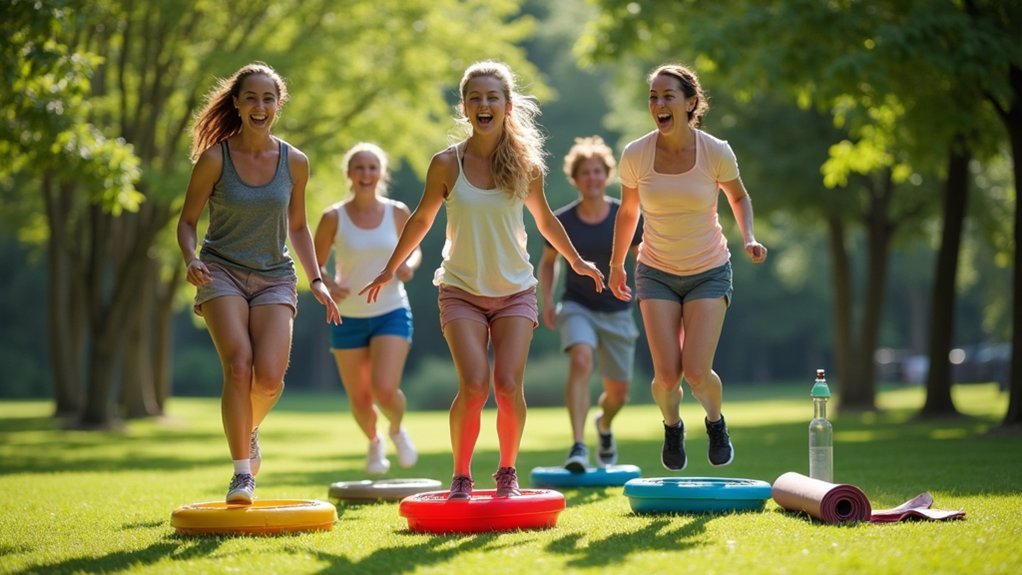
While many fitness journeys begin with intimidating equipment or complex routines, the Gentle Health Bounce offers a revitalizing simple introduction to rebounding. This low-impact exercise improves your cardiovascular health and enhances lymphatic circulation without straining your joints.
To perform the gentle health bounce, lightly press your feet into the mat with slightly bent knees. Remember to engage your core throughout the movement to promote stability and balance while developing overall strength.
As a beginner, start with just 5-10 minutes of bouncing, gradually increasing as your fitness improves. You’ll notice the benefits extend beyond physical fitness—consistent practice leads to increased energy levels, improved mood, and a growing sense of accomplishment.
The gentle health bounce is your gateway to effective, joint-friendly exercise that builds confidence with every session.
Basic Ankle Rolls and Foot Stretches for Joint Mobility
Before advancing to more dynamic rebounding movements, proper ankle and foot preparation can make your mini trampoline experience both safer and more effective.
Ankle rolls are essential foundation exercises that improve joint flexibility while enhancing your stability on the rebounder.
- Perform ankle rolls for 30 seconds in each direction to increase blood circulation
- Practice pointing and flexing your toes to enhance foot joint mobility
- Try seated calf stretches to release tension in your lower legs
- Rotate each ankle in circular motions to improve range of motion
- Maintain regular foot and ankle stretching routines to develop better proprioception
These simple movements might seem basic, but they’re vital for preventing injury during your rebounding workouts.
Don’t skip preparation – these foundation movements create the stability that prevents injuries and enhances your rebounding experience.
Your improved joint mobility will translate to better balance and more effective exercise on your mini trampoline.
Modified Mini Squats on the Trampoline
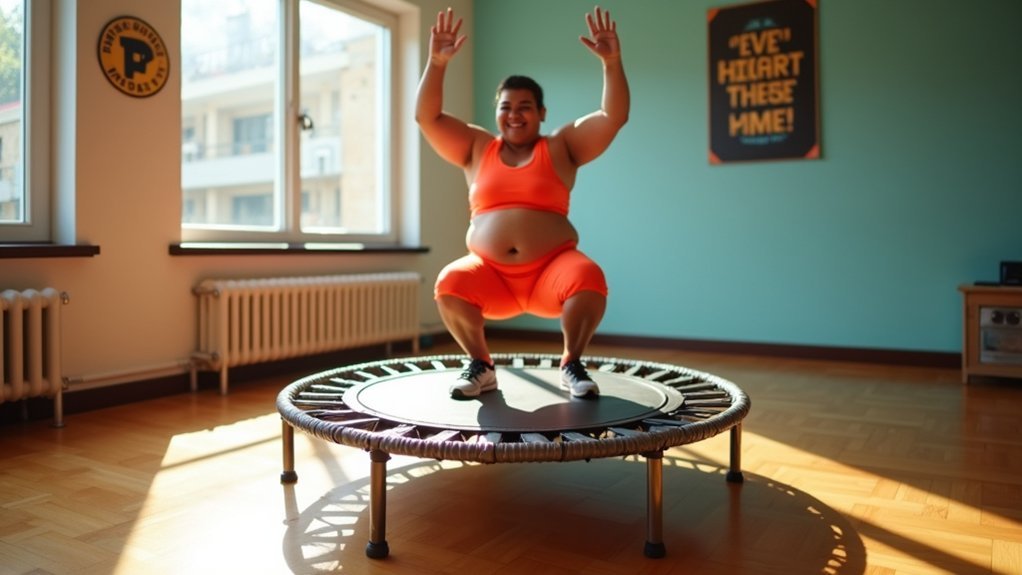
Start your modified mini squats with feet shoulder-width apart and knees slightly bent to maintain a safe, stable position on the trampoline.
Keep your back straight and core engaged as you lower into a shallow squat, only descending as far as feels comfortable for your current fitness level.
You’ll build confidence and strength gradually, so don’t rush your progress—aim for proper form over depth or repetitions.
Safety First Approach
As you begin your mini trampoline journey, modified mini squats offer an excellent way to build strength safely.
With a safety first mindset, it’s essential to master proper form before increasing intensity.
- Start with a gentle health bounce to warm up your muscles
- Position feet shoulder-width apart for ideal stability
- Bend knees while keeping your back straight and chest lifted
- Make sure your knees never extend beyond your toes
- Move at a controlled pace that feels comfortable for your body
Remember to listen to your body’s signals and adjust accordingly.
The trampoline’s bouncy surface reduces joint impact while still engaging your core and lower body muscles.
By focusing on controlled movements rather than depth, you’ll build confidence while minimizing injury risk.
Your mini squats will become more fluid as your balance and strength improve.
Proper Stance Positioning
Proper stance positioning forms the foundation for successful mini squats on your trampoline. Start by placing your feet shoulder-width apart, which creates a stable base for your exercise. Keep your chest lifted and shoulders relaxed while maintaining this position throughout the movement.
Before beginning your squat, engage your core by drawing your belly button toward your spine. This activation protects your lower back and improves your overall stability on the bouncy surface.
When you’re ready to perform the squat, bend your knees and push your hips backward as if you’re sitting in a chair. Be careful not to let your knees extend beyond your toes.
As you return to standing position, land softly by slightly bending your knees, allowing the trampoline to absorb the impact gently.
Progress at Your Pace
Embracing modified mini squats allows you to enjoy the benefits of this exercise regardless of your fitness level.
These gentle movements gradually elevate your heart rate while protecting your joints from excessive impact.
- Start with a slight knee bend while keeping your back straight and core engaged
- Begin with gentle bounces before gradually increasing your squat depth
- Raise your arms overhead during squats to maintain momentum and balance
- Focus on stability first—proper form matters more than speed or depth
- Listen to your body and rest when needed—consistency trumps intensity
As you practice regularly, you’ll notice improved muscle tone in your legs and enhanced cardiovascular fitness.
Remember that progress happens at different rates for everyone. Your journey is unique, and each session on the trampoline brings you closer to your health goals.
Seated Bouncing for Balance and Core Activation
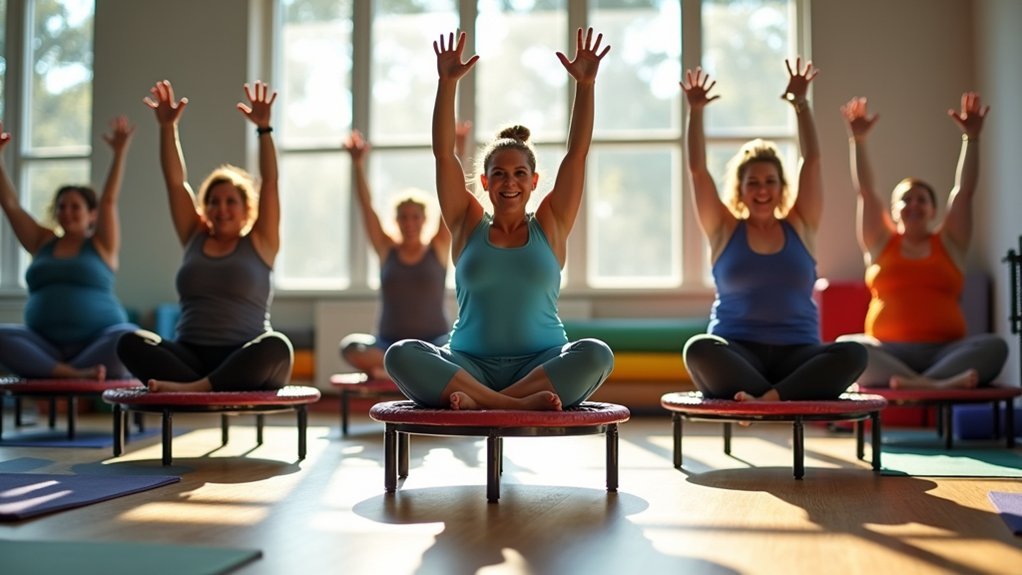
Seated bouncing on your mini trampoline is a perfect starting point for activating your core while building confidence in a stable position.
You’ll want to begin with gentle bounces, keeping your hands on the trampoline’s support handles for maximum stability as you find your rhythm.
As your balance improves, you can gradually increase your bouncing intensity and eventually try removing one hand from the support handles to challenge yourself further.
Start Slow, Progress Gradually
When starting on your mini trampoline journey, the safest approach begins with seated bouncing. This gentle exercise helps you develop stability while protecting your joints—perfect if you’re carrying extra weight. Start slow with brief 3-5 minute sessions, gradually extending your time as your confidence grows.
- Keep your posture upright to properly engage your core muscles
- Add gentle arm movements to enhance coordination and upper body involvement
- Begin with just 2-3 sessions per week, allowing recovery between workouts
- Focus on consistent, controlled bounces rather than height or speed
- Monitor how your body feels and adjust accordingly—mild muscle fatigue is normal, pain is not
As you progress, you’ll build the foundation needed for more dynamic standing exercises on your rebounder.
Support Handles Help Stabilization
Support handles on your mini trampoline offer an invaluable advantage as you build your rebounding skills. They provide a stable grip that considerably reduces fall risk while you focus on mastering proper form and technique rather than worrying about balance.
For overweight beginners, combining support handles with seated bouncing creates an ideal low-impact workout environment. This approach eases joint pressure while effectively activating your core muscles.
You’ll gain confidence as you hold the handles, allowing you to adjust bouncing intensity based on your comfort level and fitness stage.
Research shows this modified approach improves cardiovascular health and builds muscle strength without excessive strain. By gripping the support handles during your sessions, you’ll maintain stability while gradually increasing workout intensity as your skills develop.
Mild Marching in Place: Building Endurance
Beginners can start their mini trampoline journey with mild marching in place, a gentle yet effective exercise that builds endurance without straining your joints. This low-impact movement engages your legs and core while gradually improving your cardiovascular health.
- Start with just 5-10 minutes of mild marching if you’re new to exercise.
- Increase your session length to 10-15 minutes as your stamina improves.
- Add gentle arm movements to boost calorie burn and engage your upper body.
- Focus on maintaining balance and coordination with each step.
- Use this exercise as your foundation before advancing to more challenging trampoline workouts.
You’ll notice improvements in your breathing and endurance after just a few sessions, making mild marching an ideal starting point for your fitness journey.
Side-to-Side Weight Shifts for Hip Mobility
Start with small, controlled side-to-side movements to build your balance gradually while reducing impact on your joints.
As you shift your weight from foot to foot, you’ll strengthen lateral muscles that don’t get much attention in forward-focused exercises.
You’ll feel your hips opening up and becoming more mobile, which improves your stability for everyday movements.
Start Small, Build Balance
While many people focus on the bouncing aspect of mini trampolines, mastering subtle side-to-side weight shifts can dramatically improve your hip mobility and overall balance.
Start small with gentle movements, shifting your weight between feet while maintaining an engaged core for proper alignment.
- Begin with 1-2 minute intervals to reduce hip stiffness without overexertion
- Coordinate your breathing—inhale deeply as you shift weight from side to side
- Keep your core engaged to maintain proper posture throughout the movement
- Focus on controlled, deliberate shifts rather than speed or intensity
- Gradually increase duration and intensity as your comfort and strength improve
These simple shifts provide an excellent foundation for overweight beginners, enhancing joint flexibility while building the balance skills you’ll need for more advanced trampoline exercises.
Reduce Joint Impact
One of the greatest advantages of side-to-side weight shifts on a mini trampoline is how they minimize joint stress while maximizing mobility benefits.
When you’re overweight, your knees and ankles typically bear extra pressure during exercise, but the trampoline’s surface absorbs this impact.
As you gently shift your weight from side to side, you’ll engage the stabilizing muscles around your hips without straining your joints. This controlled movement helps improve your range of motion while reducing joint impact.
You’ll notice improved balance and coordination with regular practice, making everyday movements easier.
Try performing these shifts at a comfortable pace, focusing on proper form rather than speed.
This approach allows you to safely enhance hip flexibility and reduce stiffness—key benefits for beginners carrying extra weight who want to protect their joints while getting active.
Create Lateral Strength
Side-to-side weight shifts on your mini trampoline build essential lateral strength that many traditional exercises overlook.
These movements specifically target your hip abductors and adductors, improving mobility and stability in your pelvis.
- Start with gentle side to side steps, gradually widening your stance as you gain confidence.
- Focus on controlled movements rather than speed, allowing your body to develop proprioception.
- Bend your knees slightly during changes to reduce strain while maximizing hip engagement.
- Practice for 1-2 minutes initially, increasing duration as your endurance improves.
- Add arm movements (reaching side to side) to enhance core activation and balance.
As you master these lateral movements, you’ll notice improved daily function, better posture, and reduced discomfort during regular activities—benefits particularly valuable for beginners carrying extra weight.
Controlled Arm Movements While Stationary Bouncing
Elevate your mini trampoline workout by adding controlled arm movements to your stationary bouncing routine. Start with simple movements like reaching overhead or side to side while maintaining your balance on the trampoline.
These controlled arm movements engage your upper body muscles while minimizing joint impact. As you bounce, keep your shoulders relaxed and core engaged to prevent strain.
Try incorporating gentle punches or arm circles to increase your heart rate and burn more calories, making your workout more effective for weight loss.
Begin slowly and focus on proper form before increasing complexity. As your confidence builds, gradually speed up your arm movements to improve endurance.
This approach guarantees you’ll develop overall strength and coordination while protecting your joints during this low-impact exercise.
The Beginner’s Twist: Engaging Your Obliques
Transform your mini trampoline routine by incorporating the Beginner’s Twist, a simple yet effective movement that targets your oblique muscles. This low-impact exercise helps strengthen your core while improving coordination and balance—perfect for those just starting their fitness journey.
To perform the Beginner’s Twist correctly:
- Keep your feet together while rotating your torso side to side
- Maintain a tight core throughout the movement for proper spine support
- Move with control to prevent injury and maximize benefits
- Focus on engaging your obliques with each twist for better posture
- Start slowly and increase intensity as your comfort level improves
Supported Heel Lifts for Calf Strengthening
After working your core with twisting movements, let’s shift focus to strengthening your lower legs. Supported heel lifts on your mini trampoline offer an effective way to build calf strength. Go ahead and stand on the rebounder while holding onto a stable surface for balance.
| Technique Tips | Benefits |
|---|---|
| Engage your core | Improves posture |
| Rise fully onto toes | Targets gastrocnemius |
| Keep shoulders relaxed | Enhances stability |
Begin with 1-2 sets of 10-15 repetitions, gradually increasing as you build strength. This exercise specifically targets your gastrocnemius and soleus muscles, which are essential for everyday activities like walking and climbing stairs. The trampoline’s forgiving surface makes this exercise gentler on your joints while still providing effective resistance.
Progressive Cool-Down Techniques for Recovery
Once you’ve completed your mini trampoline workout, your body needs a proper shift back to its resting state. A progressive 5-10 minute cool-down gradually lowers your heart rate and prevents post-exercise dizziness or muscle soreness.
Your cool-down routine should include:
- Gentle health bounces at decreasing heights to gradually reduce intensity
- Deep breathing exercises to promote relaxation and reduce stress
- Seated calf stretches to release tension in your lower legs
- Hip and shoulder stretches to improve flexibility in major muscle groups
- Light movements to maintain blood circulation as your body recovers
Consistent cool-down practices will shorten your recovery time between workouts and reduce injury risk.
This is especially important for beginners who are overweight, as proper recovery encourages you to maintain your exercise routine.
Frequently Asked Questions
Can Overweight People Jump on Trampoline?
Yes, you can jump on a trampoline if you’re overweight. Just make certain it supports your weight, start with gentle bounces, maintain proper form, and consider consulting your doctor first for safety.
How Long Should I Jump on Mini Trampoline to Lose Weight?
You should jump on your mini trampoline for 20-30 minutes, 3-4 times weekly. You’ll burn 250-500 calories per hour, especially if you include 30-second high-intensity intervals followed by 1-2 minutes of lighter bouncing.
Can Obese People Use a Rebounder?
Yes, you can absolutely use a rebounder if you’re obese. It’s low-impact on your joints while still offering effective cardio. Start with short sessions and gradually increase duration as your fitness improves.
What Is 10 Minutes on a Rebounder Equivalent To?
Ten minutes on a rebounder is equivalent to a 30-minute brisk walk. You’ll get the same cardiovascular benefits in just one-third of the time, making it an efficient workout option for your schedule.
In Summary
Remember, you’re not just bouncing—you’re building a foundation for better health. Start with just 5 minutes daily and gradually increase as your confidence grows. Listen to your body, celebrate small victories, and don’t rush the process. Your mini trampoline journey is uniquely yours. With consistency and these beginner-friendly exercises, you’ll soon experience the transformative benefits of rebounding.

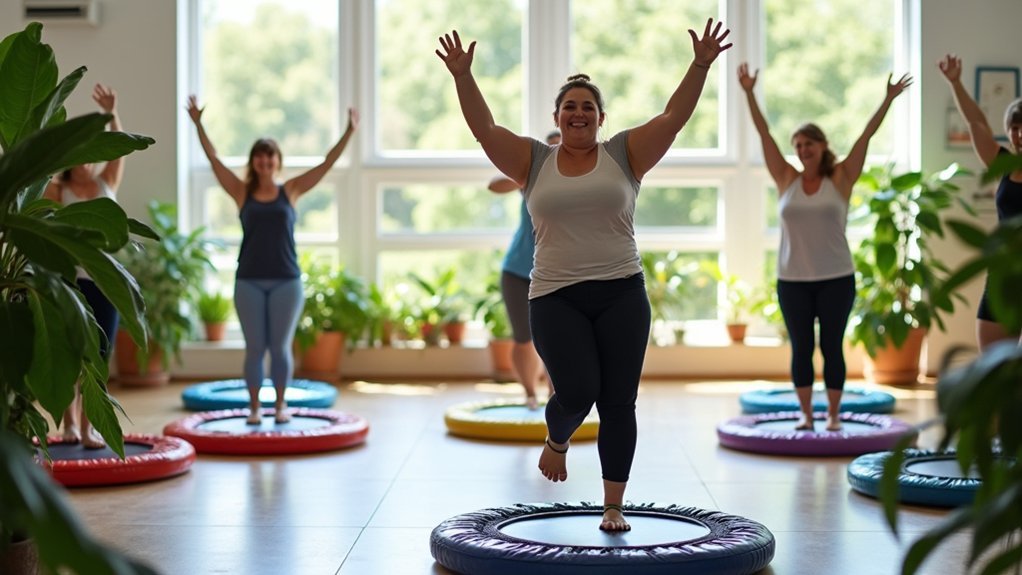

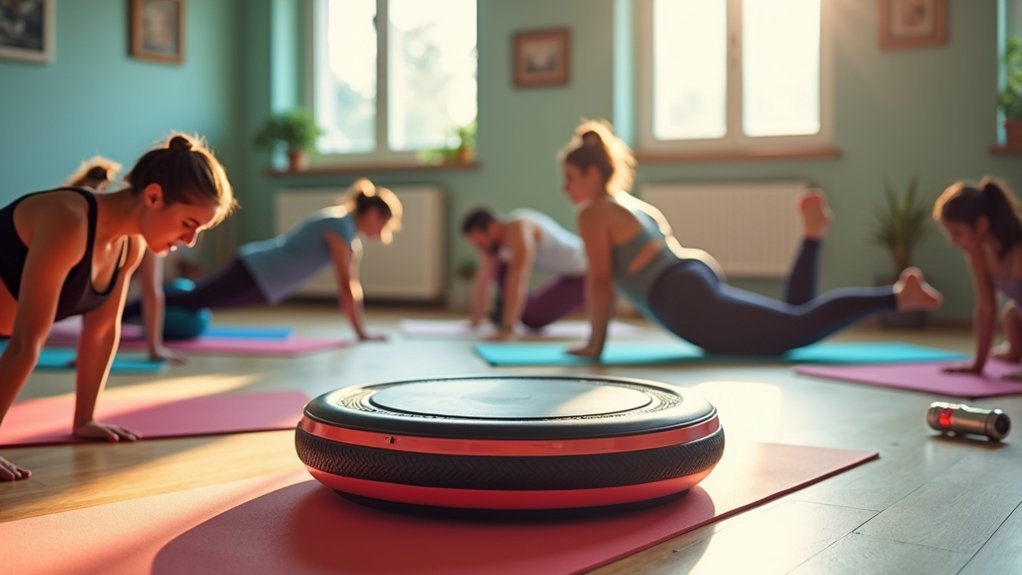
Leave a Reply